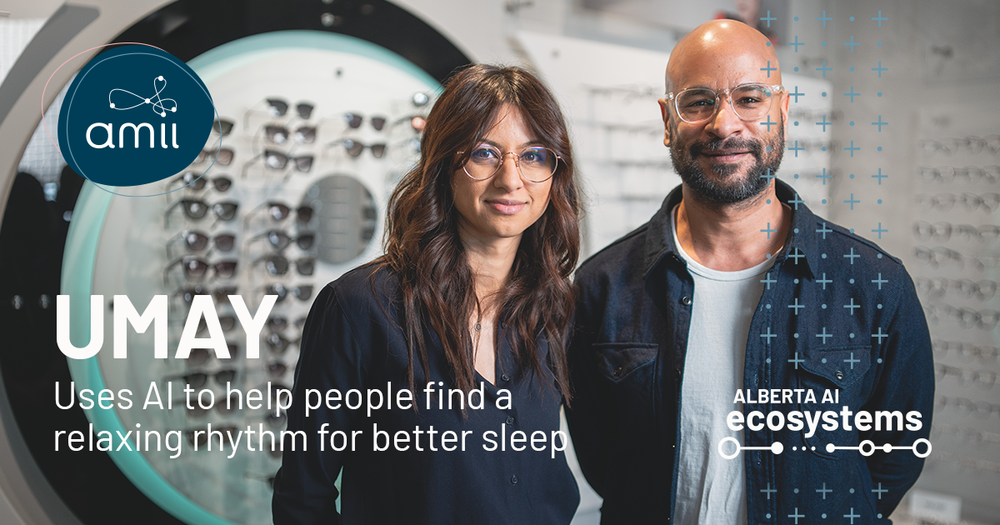Case Study
Umay uses AI to help people find a relaxing rhythm for better sleep and eye health

Add up all the time you spend staring at a screen during the day: every hour working on a laptop, every streamed show, every minute spent scrolling through your phone. If you're like most people, those moments make up the majority of your waking day -- about 11 hours for the average Canadian.
All that screen time can do a number on our eyes and our sleep patterns, according to optometrist Dr Sharmin Habib.
"It's starting to affect not only our eyes but also our mind. And more and more data is coming out on the impacts it's having on our mental health, sleep stress and digital eye strain," she says.
Dr Habib and her brother Ali Habib are co-founders of Umay, which is developing a device to combat digital eye strain with the help of artificial intelligence (AI).
The idea came as Dr Habib found many of her optometry patients were coming in with eye strain linked to heavy screen use -- including her own brother. So when he came into her office complaining of dry eyes, she prescribed him the typical treatment: soaking a towel in hot water and laying it over the eyes. It was a solution that both of them found annoying and ineffective.
"I remember being in the washroom trying to figure out. 'I don't know if this is the right temperature, and how do I put this on?' So I went to lay in my bed with the towel over my eyes and the water is dripping into my ears," he recalls.
"I just remember thinking, 'how am I supposed to do this on a regular basis?' And that's where the inspiration came from to make a more convenient way to apply this therapy."
Their answer was a device called the Umay Rest. It's shaped like pair of armless glasses, with two soft pads that a user places over their closed eyes shortly before bed. The eyepiece then runs through a nightly 5-10 minute wind-down routine that combines heating, cooling and vibration.
"What we do is help calm the mind and body right before bedtime to help promote sleep onset and also restore the function of our eyes," Ali says.
Dr Habib and Ali wanted to go further with their device by experimenting with heart rate variability (HRV). Even when someone's heart rate is stable, it doesn't beat at precisely the same rhythm every single time. Instead, there are tiny fluctuations measured in mere milliseconds. HRV is the variation in the time between those beats.
HRV may play an essential role in reducing stress and regulating things like blood pressure. While the fluctuations are largely controlled automatically by the brain, slow and deep breaths can cause our heartbeats to sync with our respiratory rate, raising HRV.
Finding the right rhythm
Umay started by recording heart rhythm and breathing rate data and analyzing the results with a machine learning system. This AI-assisted approach found a pattern that helped people best reach that state of synchronization -- a four-second inhale, followed by about six seconds of exhaling.
The pair used this information to combine guided breathing and temperature changes to help their users sync their breathing and heart rate, making it easier to wind down.
"AI helped us find that breathing frequency or variable of heat changing to help correspond with maximizing the user's benefit on reaching their state of calm," Ali says.
While AI helped the pair unlock the breathing pattern, they see many more potential uses for machine learning in the future. Wearable technology and apps are transforming personal healthcare and wellness, Dr Habib says. Umay has developed a companion app to their Rest device that tracks data from a person's wind-down sessions. She believes artificial intelligence offers the opportunity to use that data and information from other devices and sources to give people a better idea of their overall well-being.
"We're excited about leveraging AI and further develop developing the Umay app to allow users to connect with their health professional and provide even more personalized care than they have today," she says.
"I think we now live in a time where we are much more actively involved in our well-being."
This project was part of the Western Economic Diversification Canada Regional Innovation Ecosystems (RIE) program. The initiative brought together nine organizations from non-profit, business and academia to establish viable uses for artificial intelligence and machine learning in health and data analytics.
Learn more about how artificial intelligence and machine intelligence can transform your business. Discover 5 ways AI can be your business’ competitive advantage.
Let's get started!
Interested in learning more about how Amii can help you harness the potential of AI in your business?
The first step is easy: contact us! We're here if you want to float an idea or to answer any burning questions you might have. We're always happy to chat with a fellow AI enthusiast (it's absolutely our favourite topic of discussion).
Latest Case Studies

Apr 3rd 2023
Case Study
Venturi uses machine learning to reduce pipeline emissions
Machine learning is saving time and money while reducing emissions and increasing safety in the pipeline sector: find out how Venturi Engineering Solution is working towards the future of energy

Feb 6th 2023
Case Study
pipikwan pêhtâkwan harnesses AI to help reduce online hatred
Learn how the Indigenous communications company is exploring AI to reduce the hidden harm that comes with moderating racist comments online.

Sep 19th 2022
Case Study
Instrumar uses ML to improve quality & efficiency in fiber production
Synthetic fiber is everywhere. Learn how Canada-based Instrumar is using machine learning to improve quality and efficiency in fiber production.
